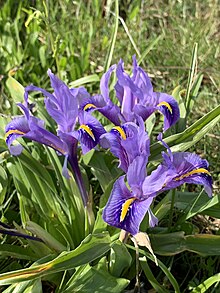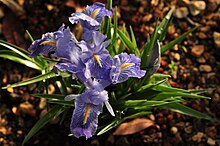
Iris is a flowering plant genus of 310 accepted species with showy flowers. As well as being the scientific name, iris is also widely used as a common name for all Iris species, as well as some belonging to other closely related genera. A common name for some species is flags, while the plants of the subgenus Scorpiris are widely known as junos, particularly in horticulture. It is a popular garden flower.

Iris subg. Scorpiris, commonly called Juno, is a subgenus of Iris, representing the smooth-bulbed bulbous irises. For a while it was an independent genus Juno Tratt. in some classifications.

Iris bucharica is a species of flowering plant in the family Iridaceae. It is a bulbous herbaceous perennial, from temperate Asia, within Afghanistan, Tajikistan and Uzbekistan. It has long blue green leaves, many flowers in spring, in shades of yellow and white.
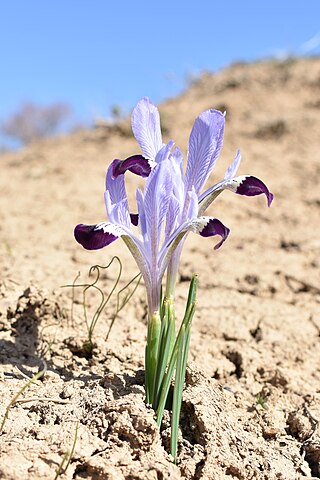
Iris kolpakowskiana, or Kolpakowski's iris, is a plant species in the genus Iris, it is classified in the subgenus Hermodactyloides and section Monolepsis. It is a bulbous perennial from Asia.
Iris pamphylica is a plant species in the genus Iris. It is the largest member of the subgenus Hermodactyloides, it is also in the section Reticulatae. It is a bulbous perennial from Antalya Province in Turkey, Asia. It has long narrow leaves, shorter stem holding a bi-coloured flower in shades of purple, blue or purple-brown, with a yellow, purple-spotted section on a petal.
Iris subg. Nepalensis is one subgenus of Iris, also known as 'Himalayan irises'. It was formerly genus Junopsis.
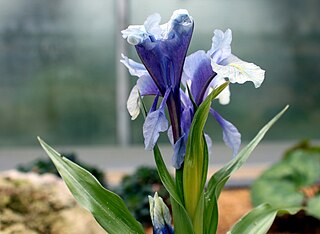
Iris cycloglossa is a species in the genus Iris, in the subgenus Scorpiris. It comes from Afghanistan.

Iris palaestina is a species in the genus Iris in the subgenus Scorpiris. It is a bulbous perennial from Asia, including the Palestine region, Lebanon, Syria and Turkey. It has long, narrow, strap-like leaves, and a short stem. The early blooming, fragrant flowers are greenish-grey/white or yellow-white.

Iris rosenbachiana, the spinster iris, is a species in the genus Iris, it is also in the subgenus Scorpiris. It is a bulbous perennial from Central Asia, within Tajikistan and Afghanistan. It has long mid-green leaves, short flower stem, sweet scented flowers in early spring in shades of purple.
Iris vicaria is a species in the genus Iris, it is also in the subgenus Scorpiris. It is a bulbous perennial from Asia, found in Tajikistan, Turkmenistan and Uzbekistan. It has tall arching leaves, and has varied coloured flowers, with white, blue and purple between April and May.
Iris zaprjagajevii is a species in the genus Iris, it is also in the subgenus Scorpiris. It is a bulbous perennial from Central Asia. It has greyish-green leaves, short stem and white flowers with a yellow crest.
Iris willmottiana is a species in the genus Iris, in the subgenus Scorpiris. It is a bulbous perennial, from Uzbekistan in central Asia. It has green broad leaves, short stems, large flowers in various shades of blue.

Iris orchioides, the 'orchid iris,' is a plant species in the genus Iris, it is also in the subgenus Scorpiris. It is a bulbous perennial, from the mountains of Uzbekistan and Kyrgyzstan. It has dark green leaves, slender stems, up to three yellow flowers in spring. It is cultivated as an ornamental plant in temperate regions.
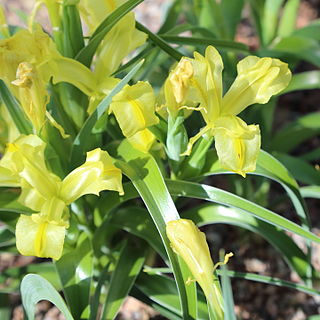
Iris maracandica is a species in the genus Iris, it is also in the subgenus Scorpiris. It is a bulbous perennial from Uzbekistan, Central Asia. It has short stems, scented spring flowers in shades of yellow.
Iris kuschakewiczii is a species in the genus Iris, subgenus Scorpiris. It is a bulbous perennial from the hills of Kazakhstan. It has dark green glaucous leaves, a short thick stem and purple spring flowers.

Iris stenophylla is a species of flowering plant in the genus Iris, it is also in the subgenus Scorpiris. It is a bulbous perennial.

Iris tubergeniana is a species in the genus Iris, it is also in the subgenus Scorpiris. It is a bulbous perennial from Central Asia, in the former states of USSR. It has pale green, pointed or sickle shaped leaves, short flowering stem holding 1-3 spring flowers in shades of yellow.
Iris falcifolia is a plant species in the genus Iris, it is also in the subgenus Iris and in the section Hexapogon. It is a rhizomatous perennial, from Uzbekistan, Kazakhstan, Afghanistan, Iran and Pakistan. It is a small plant, with sickle-shaped greyish-green leaves, lilac-violet flowers and darker veining, and a white or yellow beard. It is cultivated as an ornamental plant in dry, temperate regions.
Iris heweri is a plant species in the genus Iris, it is also in the subgenus Iris and in the section Regelia. It is a rhizomatous perennial, from Afghanistan. It has tall, green curved leaves, tall slender stems and purple blue or violet-blue flowers, with white and purple or lilac beard. It is cultivated as an ornamental plant in temperate regions.
Iris griffithii is a plant species in the genus Iris, it is also in the subgenus Iris. It is a rhizomatous perennial, from Afghanistan. It has short, sickle-shaped leaves, short green stem and purple flowers with white beards. Several specimens exist within herbaria around Europe, but it is rarely cultivated.

